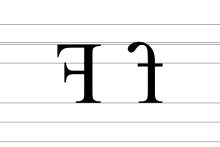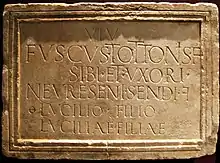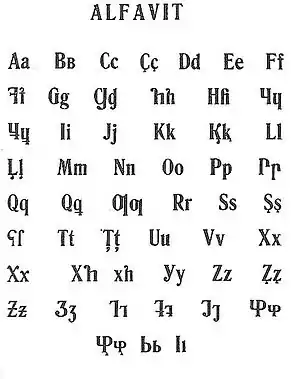Reversed F
Reversed F (ꟻ ![]() ) is an additional letter of Latin writing used in epigrahic inscriptions to abbreviate the words filia[1] or femina.[2] It was also formerly used in the writing of the Abaza, the Abkhaz, the Adyghe and the Kabardian languages in the 1920s and 1930s.
) is an additional letter of Latin writing used in epigrahic inscriptions to abbreviate the words filia[1] or femina.[2] It was also formerly used in the writing of the Abaza, the Abkhaz, the Adyghe and the Kabardian languages in the 1920s and 1930s.
| Reversed F | |
|---|---|
| ꟻ | |
 | |
| Usage | |
| Writing system | Latin script |
| Type | alphabetic |
| Language of origin | Abkhaz language, Abaza language, Kabardian language, Adyghe language |
| Phonetic usage | /ʃʷ/ |
| Unicode codepoint | U+A7FB |
| History | |
| Development |
|
| Time period | 1920s to 1930s |
| Other | |
It is not to be confused with the turned digamma ⟨Ⅎ ⅎ⟩ or with turned f ⟨ɟ⟩.
Utilisation
 Epitaph of Fuscus at Arrien-en-Bethmale (Ariège) with reversed F to abbreviate the word filiae.
Epitaph of Fuscus at Arrien-en-Bethmale (Ariège) with reversed F to abbreviate the word filiae.
Computing codes
Epigraphic reversed F can be represented with the following Unicode (Latin Extended-D) characters:
| Preview | ꟻ | |
|---|---|---|
| Unicode name | LATIN EPIGRAPHIC LETTER REVERSED F | |
| Encodings | decimal | hex |
| Unicode | 43003 | U+A7FB |
| UTF-8 | 234 159 187 | EA 9F BB |
| Numeric character reference | ꟻ | ꟻ |
See also
References
- Hübner 1885, p. lxxiv.
- Cagnat 1898, p. 374.
- Joomagueldinov, Pentzlin & Yevlampiev 2012.
Bibliography
- Cagnat, René (1898). Cours d’épigraphie latine. Paris: Fontemoing.
- Hübner, Emil (1885). Exempla Scripturae Epigraphicae Latinae (in Latin). Berlin.
{{cite book}}: CS1 maint: location missing publisher (link) - Joomagueldinov, Nurlan; Pentzlin, Karl; Yevlampiev, Ilya (18 October 2011). Proposal to encode Latin letters used in the Former Soviet Union (PDF).
- Joomagueldinov, Nurlan; Pentzlin, Karl; Yevlampiev, Ilya (29 January 2012). Revised proposal to encode Latin letters used in the Former Soviet Union (PDF).
- Perry, David J. (2006). Proposal to Add Additional Ancient Roman Characters to UCS (PDF).
This article is issued from Wikipedia. The text is licensed under Creative Commons - Attribution - Sharealike. Additional terms may apply for the media files.


.JPG.webp)
.JPG.webp)